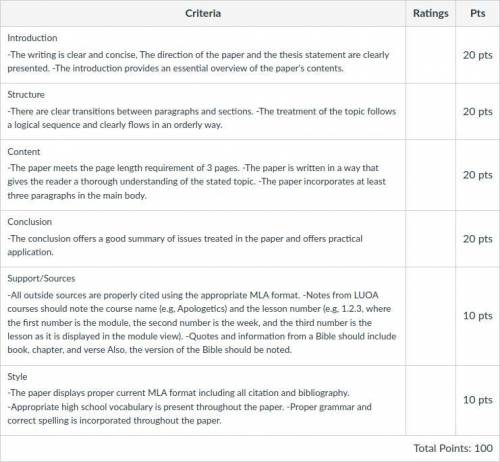
Choose one book from the Old Testament and discuss when it was written and who it was written by, what it’s about, and how you could apply its principles to your life.
Choose one character from the Old Testament and identify three godly traits displayed by this individual; explain how you could display these same traits in your life.
Choose one event from the Old Testament and explain what it’s about (provide a brief summary of the event), how something from this event could be applied to your life, and how you could share this event with someone else.



Answers: 3
Another question on English

English, 21.06.2019 18:30
1. according to mla citation style rules, when citing a book by more than one author, the authors' names should a. be listed alphabetically by first name. b. be listed alphabetically by last name. c. be listed in the order in which they appear on the title page. d. follow the title of the book. 2.which of the following items is not necessary to include in summary notes? a. all the information that is relevant to your topic and purpose b. complete publication information c. the time and date you read the source material d. specific examples 3. which of the following is not an objective of synthesizing sources? a. reviewing key ideas on a topic b. combining opinions and general statements c. exploring different points of view d. understanding the topic in depth 4.when punctuating quotations, commas and are placed inside the quotation marks. a. semicolons b. periods c. colons d. page numbers in parentheses 5. in academic writing, why would you prefer to rely on information from scholarly journals rather than magazines? a. authors in scholarly journals are generally specialists in their field. b. magazines use every-day experiences and discuss popular topics. c. scholarly journals never include visuals. d. scholarly journals are more difficult to find, and therefore more valuable. 6.when punctuating direct quotations, use a after the verb that introduces the quotation. a. comma b. dash c. colon d. seimicolon
Answers: 1

English, 21.06.2019 19:30
If your job was precarious,would you look for a new one? explain.
Answers: 1

English, 22.06.2019 01:30
In at least 150 words, discuss the symbolic significance of janie’s hair in their eyes were watching god
Answers: 1

English, 22.06.2019 01:50
Plagiarism quiz read both the paragraph below and the information following it that identifies the source using the american psychological association format. then read each of the numbered statements and determine if each is plagiarized or not. circle “yes” if the statement is plagiarized, “no” if it is not, and then fix the “yes” answers). original source the presence of the taiwanese on everest was a matter of grave concern to most of the other expeditions on the mountain. there was a very real fear that the taiwanese would suffer a calamity that would compel other expeditions to come to their aid, risking further lives, to say nothing of jeopardizing the opportunity for other climbers to reach the summit. but the taiwanese were by no means the only group that seemed egregiously unqualified. camped beside us at base camp was a twenty-five-year-old norwegian climber named peter neby, who announced his intention to make a solo ascent of the southwest face, one of the peak’s most dangerous and technically demanding routes—despite the fact that his himalayan experience was limited to two ascents of neighboring island peak, a 20,274-foot bump that required little more than vigorous walking. krakauer, j. (1998). into thin air: a personal account of the mount everest disaster. new york: anchor books, 122 - 3. student samples yes 1. there was a very real fear that the taiwanese would suffer a calamity that would compel other expeditions to come to their aid(krakauer, 1998). no) 2. many climbers overestimate their abilities, as krakauer (1998) explains when he writes of peter neby, whose himalayan experience in the past “required little more than vigorous walking” (122 - 3). no 3. jon krakauer (1998) discusses other concerns besides those of unpredictable weather and his own climbing group’s capabilities. for example the existence of a taiwanese group on everest was a matter of serious unease to most everyone else on the mountain. yes/no 4. krakauer (1998) states that the taiwanese group was not the only inexpert climbers to attempt mt. everest: camped beside us at base camp was a twenty-five-year-old norwegian climber named peter neby. . [whose] himalayan experience was limited to two ascents of neighboring island peak, a 20,274-foot bump that required little more than vigorous walking (122 – 3). yes/no 5. the author asserts that the taiwanese “were by no means the only group that seemed egregiously unqualified.” yes/no 6. in his book into thin air, jon krakauer (1998) discusses many of the dangers he noted prior to his disastrous attempt to climb mt. everest in 1996. among them were encounters with other groups and individual climbers who were ill-trained and ill-equipped to handle the demands of such a climb.
Answers: 2
You know the right answer?
Choose one book from the Old Testament and discuss when it was written and who it was written by, wh...
Questions


Arts, 20.01.2021 06:10

Mathematics, 20.01.2021 06:10

Biology, 20.01.2021 06:10

English, 20.01.2021 06:10


Health, 20.01.2021 06:10

Mathematics, 20.01.2021 06:10

Mathematics, 20.01.2021 06:10


Biology, 20.01.2021 06:10

Mathematics, 20.01.2021 06:10





Mathematics, 20.01.2021 06:10


Biology, 20.01.2021 06:10



